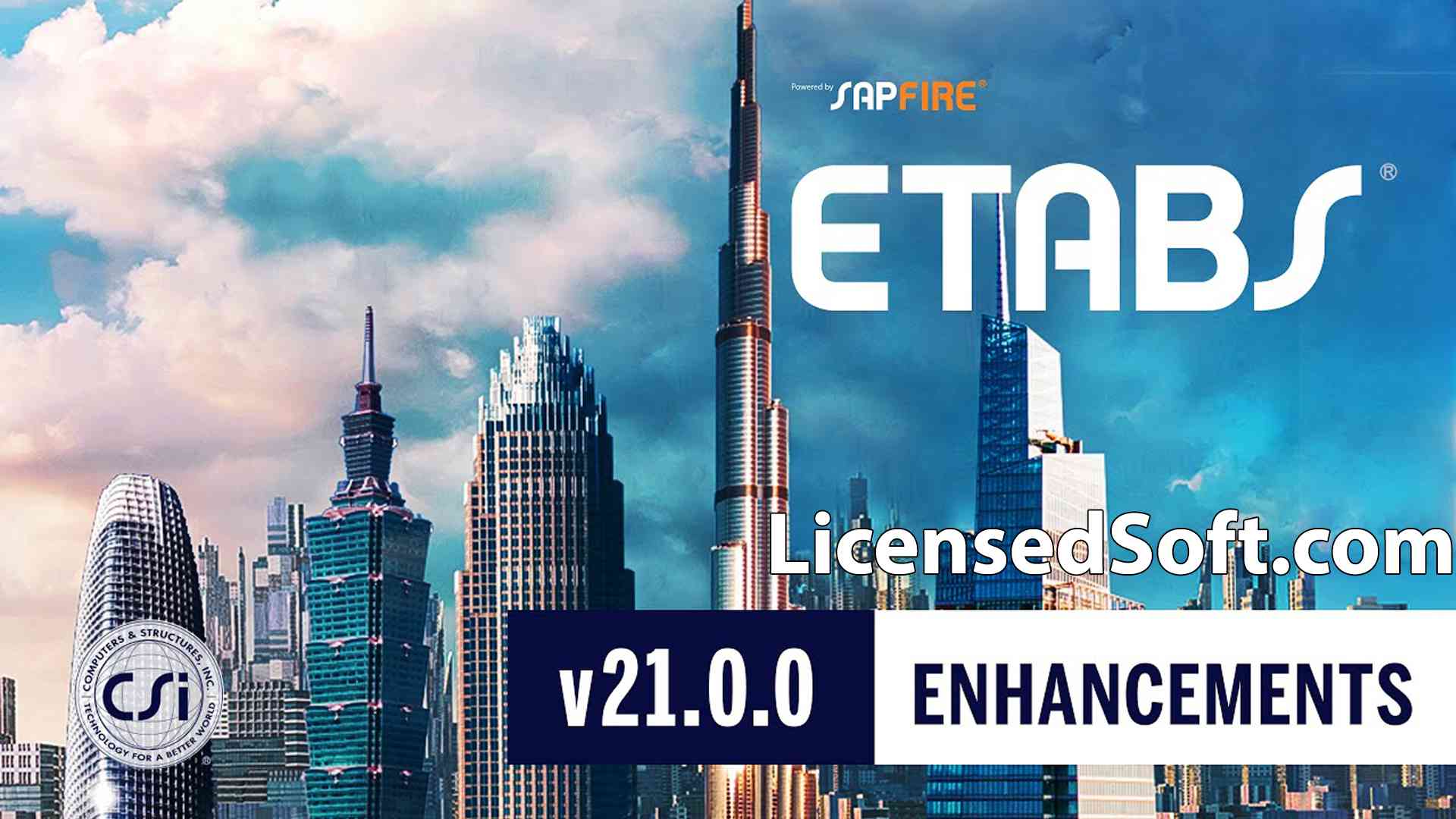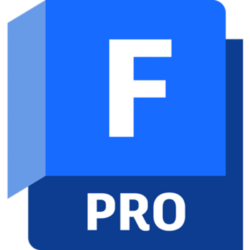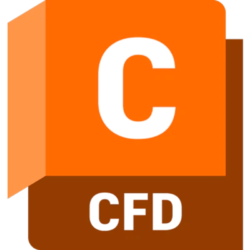ETABS Ultimate 21 is a building structure analysis and design software developed by CSI, which is widely used in the world and is the industry standard of building structure analysis and design software. Caters to multistory building analysis and design. Modeling tools and templates, code-based load prescriptions, analysis methods and solution techniques, are all coordinated with the grid-like geometry unique to this type of structure. Basic or advanced systems under static or dynamic conditions can evaluated using ETAB.
For complex assessments of seismic performance, modal and direct integration time history analyzes may coupled with P-Delta and large displacement effects. Intuitive and integrated functions make applications of any complexity practical. Interoperability with a range of design and documentation platforms makes ETAB a coordinated and efficient design tool for everything from simple 2D frameworks to well-designed modern high-rise buildings.
This release now integrates all concrete and steel detailing, including drawing production and management, for modeling, analysis and design within the same interface. The latest US and Canadian loading codes have added, along with new design codes, enhanced output of cracked slab and nonlinear shear wall performance, and other enhancements.

ETABS Ultimate 21 New Features:
1. Link Elements
ETABS has a number of different link elements available to the user to accurately represent the behavior of the structure. Link element types include linear, multi-linear elastic, multi-linear plastic, gap, hook, damper, friction isolator, rubber isolator, T/C isolator, and triple pendulum isolator.
2. Floor Membranes
Rigid, semi-rigid and flexible floor membranes can defined in ETABS. Membranes can assigned to joint objects or region objects. You can also get Tekla Structures 2023 SP4 By LicensedSoft.
3. Code-Based Automatic Loading
ETABS will automatically generate and apply seismic and wind loads according to various domestic and international codes.
4. Points, Lines, Areas and Thermal Loads
ETABS is very powerful at distributing loads. Uniform or uneven surface loads can distributed in any direction, not just gravity. Uniform or trapezoidal loads can defined on the line in any direction. Heat loads can be assigned to joints, lines and regions.
5. Reduced Live Load
Live load reduction factors can assigned on a member-by-member basis. This can done within the GUI, once the design is complete, by right-clicking on members, or it can done using interactive database editing.
6. Dynamics
ETABS dynamic analysis capabilities include computation of vibrational modes using Ritz or Eigen vectors, response spectrum analysis, and time history analysis of linear and nonlinear behavior.
7. P-delta
P-delta analysis captures the softening effects of compression and the hardening effects of tension. A single P-delta analysis under gravity and sustained loads can used to modify the stiffness for linear load cases, which can subsequently superimposed. Alternatively, fully nonlinear P-delta effects for each load combination can be analyzed. All elements incorporate P-delta effects and are seamlessly integrated into analysis and design.
8. Buckling
The linear (bifurcated) buckling mode of the structure can found under any set of loads. Buckling can calculated from nonlinear or piecewise construction states. A fully nonlinear buckling analysis is also possible taking into account P-delta or large deflection effects. Rapid buckling behavior can captured using static analysis with displacement control. Dynamic analysis can be used to model more complex buckling, such as driven load problems.
9. Pushover
Pushover analysis capabilities in ETABS include implementation of FEMA 356 and options for stress-strain based hinges and fiber optic hinges. Nonlinear layered shell elements enable users to consider the plastic behavior of concrete shear walls, slabs, steel plates, and other domain finite elements in pushover analyses. Force-deformation relations are defined for steel and concrete hinges.
10. Load Cases and Combinations
ETABS allows an unlimited number of load cases and combinations. Load combination types include linear additive, envelope (min/max), absolute additive, SRSS and range combined. Combination components may include other combinations.
Introduction of New Functions:
1. New database table
- Tables have extended to fully define the model and results.
- Most model definition tables can edited interactively.
- Tables can exported in Excel, Access, Text or XML format.
- Exported tables can edited and reimported to define new models or to add to existing models.
2. Concrete frame design
- Added Australian Code AS 3600-2018.
- Added Korean Code KBC 2016, including seismic design requirements.
- Added Mexican Construction Code (Mexico RCDF 2017).
- New Zealand code NZS 3101-06 now adopts the torsional design of the beam.
- The design of the Russian code SP 63.13330.2012 has significantly extended and enhanced, including the addition of crack width analysis for concrete beams.
- Added Turkish code TS 500-2000 (R2018), including seismic design requirements.
3. Shear wall design
- Added Australian Code AS 3600-2018.
- Added Korean Code KBC 2016, including seismic design requirements.
- Added Mexican Construction Code (Mexico RCDF 2017).
- Added Russian code SP 63.13330.2012.
- Added Turkish code TS 500-2000 (R2018), including seismic design requirements.
- Tracking of wall legs in 3D walls has enhanced to handle intermediate transverse walls.
4. Tablet design
- Added Russian code SP 63.13330.2012.
5. Steel frame design
- Added Korean Code KBC 2016, including seismic design requirements.
- The design of the Russian code SP 16.13330.2011 has significantly expanded and enhanced.
6. Composite beam design
- The AISC 360-16 code now has the option to consider axial forces in composite beams.
- The AISC 360-16 code can now design toothed and honeycomb profiles as specified in AISC Design Guide 31.
- The design of Eurocode 4-2004 has extended and enhanced.
7. Analysis
- Enhanced control is now available for the stiffness and damping of nonlinearly linked objects, including isolators, resulting in improved control over energy dissipation behavior.
- It is now possible to combine event stepping and row search for nonlinear static analysis.
- Convergence performance of friction pendulum isolators is improved for cases of significant variation in axial force, including humping.
8. Performance-Based Design
- Linear and quadrilateral strain gauges and acceptance criteria can defined to measure deformation, shear and rotation (limit levels).
9. Enhanced output
- Results for multi-step case load combinations are now available step-by-step, including plotting and tabulating results.
- Absolute and relative displacements, velocities and accelerations are now available for generalized displacements.
10. Efficiency
- Frame and wall designs are faster for all design codes and materials when considering many load combinations (e.g. time histories) containing multi-step load cases.
- Analytical models can created faster when remeshing objects are not required.
- Faster display of results for modal time history load cases including FNA for large models with multiple modes.
- The size of the stored results is reduced and can used for direct integration of time history load cases.
- Faster recovery of analysis results from application programming interfaces (APIs).
11. Application programming interface (API)
- Starting with ETABS v18, the API will compatible with future major versions of ETABS until breaking changes are required in the API itself.
- The new cross-product API can used with CSI products ETABS, SAP2000 and CSiBridge.
- New database tables can accessed in a variety of formats.
- New model database tables can edited in multiple formats and behave like interactive editing of database tables.
Software Features
The following list represents only a subset of the systems and analyzes that CSI ETABS can easily handle:
- Multi-tier commercial, government and medical institutions
- Parking lot with circular and linear ramps
- Buildings with curved beams, walls and floor edges
- Buildings with steel, concrete, composite or joist floor frames
- Multi-tower project
- Complex shear walls and cores with arbitrary openings
- Performance-based design using nonlinear dynamic analysis
- Buildings based on multiple rectangular and/or cylindrical grid systems
- Slab and Waffle Slab Concrete Buildings
- Buildings are subjected to various vertical and lateral load conditions and combinations, including automatic wind and seismic loads
- A variety of response spectrum load conditions, with built-in input curves
- Automatically transfer vertical loads on the floor to beams and walls
- Capacity check of beam-to-column and beam-to-beam steel connections
- P-Delta analysis with static or dynamic analysis
- Explicit deformation of panel areas Punching shear inspection of concrete slabs
- Construction sequence load analysis
- Multiple linear and nonlinear time-history load cases in any direction
- Foundation/support settlement
- Large displacement analysis
- Nonlinear static pushover
- Buildings with foundation isolators and shock absorbers
- Design optimization of steel and concrete frames
- Lightly reinforced and post tensioned concrete slabs
- Design capacity check of steel column base plate
- Floor molding with rigid or semi rigid diaphragms
- Automated Vertical Activity Load Reduction and much more!
System requirements details
- Supported OS: Windows 7/8/10 (64-bit)
- Processor: Intel i5/i7, AMD Athlon X4/Ryzen or better
- RAM: 8 GB RAM (16 GB recommend)
- Available hard disk space: 6 GB or more




